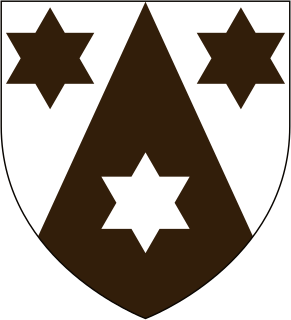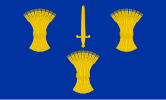Related Research Articles

Whitefriar Street Carmelite Church is a Roman Catholic church in Dublin, Ireland maintained by the Carmelite order. The church is noted for having the relics of Saint Valentine, which were donated to the church in the 19th century by Pope Gregory XVI from their previous location in the cemetery of St. Hippolytus in Rome.
White friars are members of the Order of Carmelites.
Ipswich Whitefriars was the medieval religious house of Carmelite friars which formerly stood near the centre of the town of Ipswich, the county town of Suffolk, UK. It was the last of the three principal friaries to be founded in Ipswich, the first being the Ipswich Greyfriars (Franciscans), under Tibetot family patronage before 1236, and the second the Ipswich Blackfriars (Dominicans) founded by King Henry III in 1263. The house of the Carmelite Order of White Friars was established in c. 1278–79. In its heyday it was the home of many eminent scholars, supplied several Provincial superiors of the Order in England, and was repeatedly host to the provincial chapters of the Order.

Our Lady of Doncaster is a Marian shrine located in Doncaster, South Yorkshire, England. The original statue in the Carmelite friary was destroyed during the English Reformation. A modern shrine was erected in St Peter-in-Chains Church, Doncaster in 1973. The feast day of Our Lady of Doncaster is 4 June.
Whitefriars was a Carmelite friary on the lower slopes of St Michael's Hill, Bristol, England. It was established in 1267; in subsequent centuries a friary church was built and extensive gardens developed. The establishment was dissolved in 1538.

The Cambridge Whitefriars, or Newnham Whitefriars, were a community of Carmelite friars who first settled in Chesterton outside Cambridge in the thirteenth century. Although granted permission by Henry III to build a house there in 1247, they instead moved into a house in Newnham donated to them by Michael Malherbe in 1249. It was situated in the parish of St-Peter-outside-the-gate in Trumpington and so fell under the jurisdiction of the Hospital of St John the Evangelist. Extensive monastic cells, a cloister and a church were constructed on three acres of land in Newnham. In 1290, however, because frequent flooding made it difficult to attend lectures and acquire provisions, the friars obtained permission from Edward I to move to land on Milne Street within Cambridge. They remained there from 1292 until 1538, when, as a result of the dissolution of the monasteries under Henry VIII, their property was handed over to Queens' College, who demolished the monastic buildings. The site is now occupied by Walnut Tree Court and the college chapel. The only surviving remains can be seen in the well-preserved north wall of the Fellows' Garden, which formed the north wall of the Carmelite church. The locations of the sites in Chesterton and Newnham are unknown.

Whitefriars, also known as the White Friars or The College of Carmelites, Gloucester, England, was a Carmelite friary of which nothing now survives.
Lossenham Friary was a Carmelite friary in Newenden in the Weald of Kent, England.

Boston Friary refers to any one of four friaries that existed in Boston, Lincolnshire, England.

The Carmelite Friary, King's Lynn, also Whitefriars, King's Lynn, was a friary of the Carmelites in King's Lynn, Norfolk, England. It was founded before 1261; according to Francis Blomefield, the county historian, the founder was William Bardolf, whose descendant, William Bardolf, Lord Bardolf, was buried there. In the early part of the 15th century the theologian and preacher Alan of Lynn was a member of the community. The friary was dissolved in 1538.
York Carmelite Friary was a friary in York, North Yorkshire, England, that was established in about 1250, moved to its permanent site in 1295 and was surrendered in 1538.
Greyfriars Nottingham was a Franciscan friary in Nottinghamshire, England. It was founded c. 1224–1230, and dissolved in 1539 as part of King Henry VIII's Dissolution of the Monasteries. The site of the friary is now occupied by the Broadmarsh Shopping Centre.

The buildings known as Whitefriars are the surviving fragments of a Carmelite friary founded in 1342 in Coventry, England. All that remains are the eastern cloister walk, a postern gateway in Much Park Street and the foundations of the friary church. It was initially home to a friary until the Dissolution of the Monasteries. During the 16th century it was owned by John Hales and served as King Henry VIII School, Coventry, before the school moved to St John's Hospital, Coventry. It was home to a workhouse during the 19th century. The buildings are currently used by Herbert Art Gallery and Museum, Coventry.
Whitefriars is an area in the Ward of Farringdon Without in the City of London. Until 1540, it was the site of a Carmelite monastery, from which it gets its name.

More House is the Catholic chaplaincy for the University of York in Heslington, York. The building itself dates from the late 18th century. The chaplains were formerly Carmelite friars resident in the building, but since 2021 priests from York Oratory have been ministering to the chaplaincy. It is located on Main Street in Heslington, which is towards the south edge of "Campus West". It is a Grade II listed building.
References
- ↑ British History Online: A P Baggs, Ann J Kettle, S J Lander, A T Thacker and David Wardle, "Friaries: The Carmelites of Chester", in A History of the County of Chester: Volume 3, ed. C R Elrington and B E Harris (London, 1980), pp. 176-178
- ↑ Heritage Gateway: Historic England Research Records - Chester Whitefriars
Coordinates: 53°11′19.75″N2°53′35.61″W / 53.1888194°N 2.8932250°W
